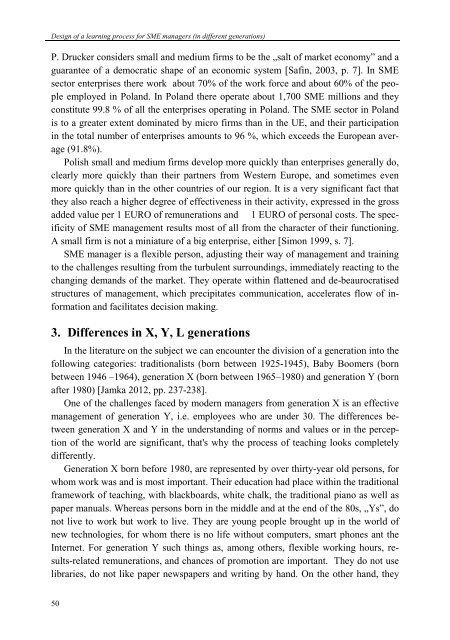Creating-entrepreneurial-mindset
Creating-entrepreneurial-mindset
Creating-entrepreneurial-mindset
- No tags were found...
Create successful ePaper yourself
Turn your PDF publications into a flip-book with our unique Google optimized e-Paper software.
Design of a learning process for SME managers (in different generations)P. Drucker considers small and medium firms to be the „salt of market economy” and aguarantee of a democratic shape of an economic system [Safin, 2003, p. 7]. In SMEsector enterprises there work about 70% of the work force and about 60% of the peopleemployed in Poland. In Poland there operate about 1,700 SME millions and theyconstitute 99.8 % of all the enterprises operating in Poland. The SME sector in Polandis to a greater extent dominated by micro firms than in the UE, and their participationin the total number of enterprises amounts to 96 %, which exceeds the European average(91.8%).Polish small and medium firms develop more quickly than enterprises generally do,clearly more quickly than their partners from Western Europe, and sometimes evenmore quickly than in the other countries of our region. It is a very significant fact thatthey also reach a higher degree of effectiveness in their activity, expressed in the grossadded value per 1 EURO of remunerations and 1 EURO of personal costs. The specificityof SME management results most of all from the character of their functioning.A small firm is not a miniature of a big enterprise, either [Simon 1999, s. 7].SME manager is a flexible person, adjusting their way of management and trainingto the challenges resulting from the turbulent surroundings, immediately reacting to thechanging demands of the market. They operate within flattened and de-beaurocratisedstructures of management, which precipitates communication, accelerates flow of informationand facilitates decision making.3. Differences in X, Y, L generationsIn the literature on the subject we can encounter the division of a generation into thefollowing categories: traditionalists (born between 1925-1945), Baby Boomers (bornbetween 1946 –1964), generation X (born between 1965–1980) and generation Y (bornafter 1980) [Jamka 2012, pp. 237-238].One of the challenges faced by modern managers from generation X is an effectivemanagement of generation Y, i.e. employees who are under 30. The differences betweengeneration X and Y in the understanding of norms and values or in the perceptionof the world are significant, that's why the process of teaching looks completelydifferently.Generation X born before 1980, are represented by over thirty-year old persons, forwhom work was and is most important. Their education had place within the traditionalframework of teaching, with blackboards, white chalk, the traditional piano as well aspaper manuals. Whereas persons born in the middle and at the end of the 80s, „Ys”, donot live to work but work to live. They are young people brought up in the world ofnew technologies, for whom there is no life without computers, smart phones ant theInternet. For generation Y such things as, among others, flexible working hours, results-relatedremunerations, and chances of promotion are important. They do not uselibraries, do not like paper newspapers and writing by hand. On the other hand, they50





